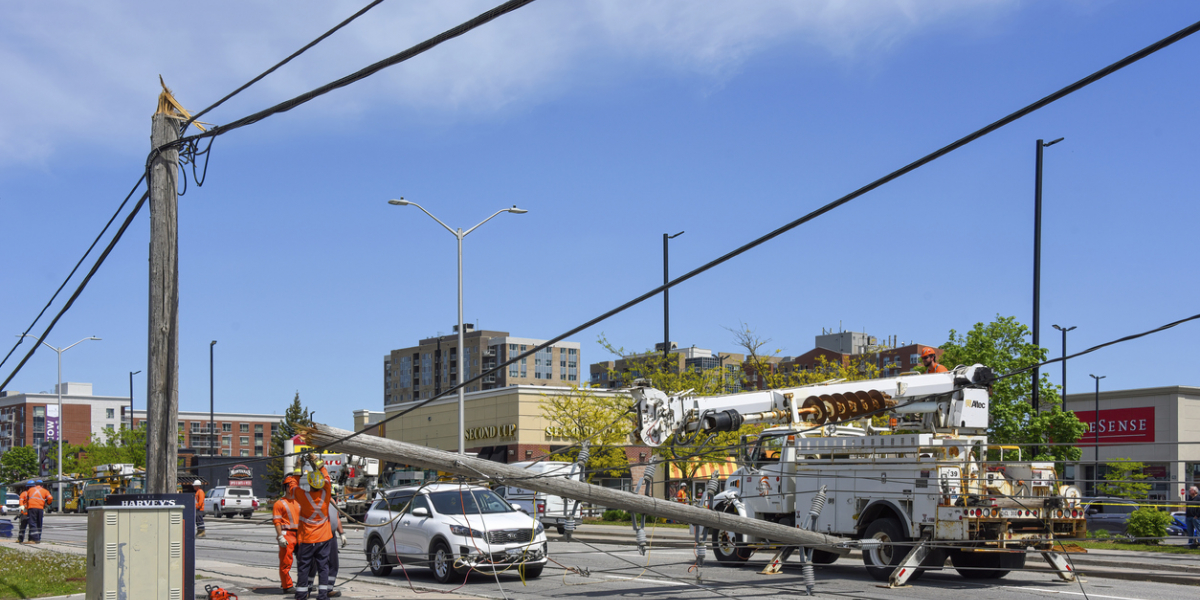
June 2, 2022
By Harshini Ramesh and Aline Coutinho
On May 21, 2022, a devastating, fast-moving thunderstorm, also known as derecho, caused widespread wind damage in parts of Ontario and Quebec. In Ottawa, it is estimated that approximately 350,000 local customers lost power immediately after the storm. Hydro Ottawa even described the damage to the power grid as “beyond comprehension”, worse than the 1998 ice storm or the 2018 tornadoes. In this blog, we combine available evidence to make the case that preparedness against climate-induced disasters and power outages requires an intersectional lens.
Climate change increases the risk of grid failures and power outages, through extreme weather events. It is estimated that due to climate change, “Canada’s electricity system is paying $1.5 billion more each year”. By the end of the century, it is projected that without mitigation measures, provincial electricity systems will bear CAD $1-4.5 billion in costs due to climate change impacts. However, the consequences of these power outages go beyond grid infrastructure damage. For example, it has been noted that the recent power outages led to spoiled food, exacerbating local food insecurity. Schools and daycare centres were closed. Those who fled domestic violence or who rely on crisis lines and supports may also be experiencing re-traumatizing triggers.
Understanding the health and safety risks from power outages is crucial to recognizing why those with disabilities or with underlying health conditions face increased climate vulnerability. Research on power outages in New York City reveals that seniors and those relying on either caregivers to perform daily activities or electric medical devices, are at greater risk. Mass power outages can disproportionately impact those who are home-bound due to medical fragility or are chronically ill due to challenges around mobility and reliance on power-dependent durable medical equipment, as evidenced during Hurricane Irma.
When energy infrastructure fails and the power goes out, the implications are felt across other critical infrastructure, impacting multiple dimensions of livelihoods. The loss of electricity can impact transportation, telecommunications, water infrastructure, disrupt supply chains, affect health care provision, and so on. These rippling effects are known as cascading impacts. In Nunavut, for example, electricity disruptions following the destruction of an aging diesel power plant by fire led to months-long interruptions in critical public services in the communities. The impact was felt in the Pangnirtung airport, which posed challenges to food delivery, medical evacuations, and other essential services in the region. Minority groups, low-income individuals, and the elderly face disproportionate vulnerabilities and risks.
Preparedness for power outages, in the context of disasters, is a crucial component of building resilience to climate change. Inadequacy in preparedness has implications for how well communities or individuals are able to cope with climate disaster events. Failures in planning have implications for the groups that face the most severe impacts of power outages and their aftermath.
Emerging research from the United States suggests that ethnic minorities, the elderly, and families with young children have lower preparedness to power outages. Low income households can experience barriers to preparedness due to limited ability to purchase supplies. Absence of culturally sensitive materials, such as information available in multiple languages, can also impact the perception of preparedness and communication of risk. The elderly, due to social isolation and health concerns, are particularly predisposed to lower preparedness and therefore at greater risk of falling, heat illness, and death, among other adverse health effects. Access to technology and information during a climate event is another key factor that drives vulnerability to climate hazards.
Within Canada, rurality and gender are also likely to play a role in preparedness for power outages. Coastal communities in Atlantic Canada experience heightened vulnerability to climate hazards, driven by factors such as an aging population, youth outmigration, dependency on resource-based sectors, and geographic isolation. Rural regions face particular vulnerabilities due to precarious and underfunded infrastructure. A study on the gendered experiences and perceptions after the 2010 winter storm in Atlantic Canada indicates that, although both men and women experienced similar impacts due to the storms, women tended to more often report concerns about flooding in their homes, loss of personal belongings, and damage to community infrastructure (e.g., damage to community centres), while men expressed more often concerns about infrastructure damage (e.g., roads, clogged sewage, damage to wharfs, and personal vehicles) and relocation.
This latest derecho storm is another stark reminder of the climate crisis and the scale of damage extreme weather events can cause. Smart Prosperity Institute recently released the Shed Light, Build Resilience series synthesizing research evidence on how climate impacts are intersectional. The literature on the nexus between climate change, energy systems, and gender is still scarce in Canada. Future research can further uncover how vulnerable groups experience the impacts of power outages during climate hazards, as well as prepare for future outage events.
There is also a need for intersectional and gender lenses in disaster preparedness responses and policies, without which we are likely to leave those most impacted in a greater state of vulnerability. Without understanding who is at the frontlines and how they are impacted, our ability to prepare communities for resilience will be greatly reduced. The time is now to improve understanding of the intersectional impacts of climate change, raise awareness of climate risks, and connect research evidence to policy making, disaster preparedness, and adaptive capacity building strategies.